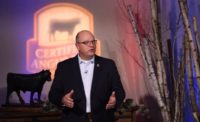“Meat heads” by education and experience, the seasoned scientists and number crunchers analyze the newest data set on the scatter plot in front of them. Coffee fuels the banter as they discuss where the figures point toward progress.
Friday mornings are when analysis happens for the packing team at Certified Angus Beef. The team of seven dig deep into the data and the science of the beef behind the logo.
Meat scientist Daniel Clark brings a new scatter plot to each weekly meeting along with a fresh perspective of the data to answer last week’s questions.
More than 2.6 million data points fill the screen, each dot measuring how carcasses meet the 10 brand quality specifications — providing insights at areas for improvement. Discussion centers around adjustments to help premium supply meet the growing demand.
Changes don’t happen overnight.
New decisions are based on science, data, years of analysis and plenty of conversation. The brand’s integrity is tied to the 10 specifications, so they don’t evolve without careful consideration and positive results.
“The beef community’s best interests are top of mind when we look at this data,” says Clark. “The first question we ask when considering an update is: How it will affect our partners up and down the supply chain?”
Beyond the grading stand
On September 9, 2020, Certified Angus Beef is implementing two changes to the G1 schedule specifications.
The first, a subtle word change, adjusts the fat thickness specification from “less than 1 inch” to read “1 inch or less.” It might sound the same, but the data show the word swap allows USDA graders more accurate measurements. Camera grading precision technology measures fat thickness out several decimal places. The change simply provides consistency and clarity when calculating by fractions of an inch.
The second change evolves ribeye area specifications providing packers the opportunity to access more Certified Angus Beef product. This creates the option for packers to evaluate carcasses by specific sub primal qualifications, complementary to total carcass evaluation.
The expanded product specification for rib eye area allows packing partners with an extended licensing agreement to box specific primals from carcasses meeting all quality specifications with maximum 19-square-inch ribeye area. Ribs, ribeyes, strip loins and short loins from these carcasses will be excluded from brand.
This approach opens the door for foodservice and retail partners to access Certified Angus Beef briskets, tenderloins, short ribs and end meats for roasts and ground beef from those carcasses. The exclusion of larger ribeyes, ribs, strip and short loins, maintains brand-quality plate presentations and thicker cuts for the key middle-meat items. Box quality, consistency and center-of-the-plate steaks presentation standards remain the same.
“I don’t want to overstate the magnitude of the expanded specification, but it is one small step in one big direction,” Clark says. “This is exciting for the future of the brand and for our partners on all fronts.”
Based on the data analyzed, the size differentiation of cuts entering the box from the designated ribeye evaluated carcasses will have little to no impact on the size or weight of the box.
Today, there are licensed packing partners considering the implementation of the designated ribeye evaluation.
“The expanded product specification is voluntary for packers, and may be incorporated when timing is right to satisfy customer demand on a plant-by-plant basis,” Clint Walenciak, Certified Angus Beef director of packing, says.
Next Friday, the packing team will evaluate data again, searching for new clues on how to make the best, better.
It’s a team effort to crunch the numbers, balance the science and calculate the scope of the adjustments. It’s using science to improve production, while never sacrificing quality — evolving the specifications if necessary to raise the standard.
“These changes set the stage for more positive changes for the future,” Walenciak says. “We are always looking for ways we can improve our product and provide a better experience.”
Progress is a process that happens one dataset, conversation and cup of coffee at a time.
Source: Certified Angus Beef







